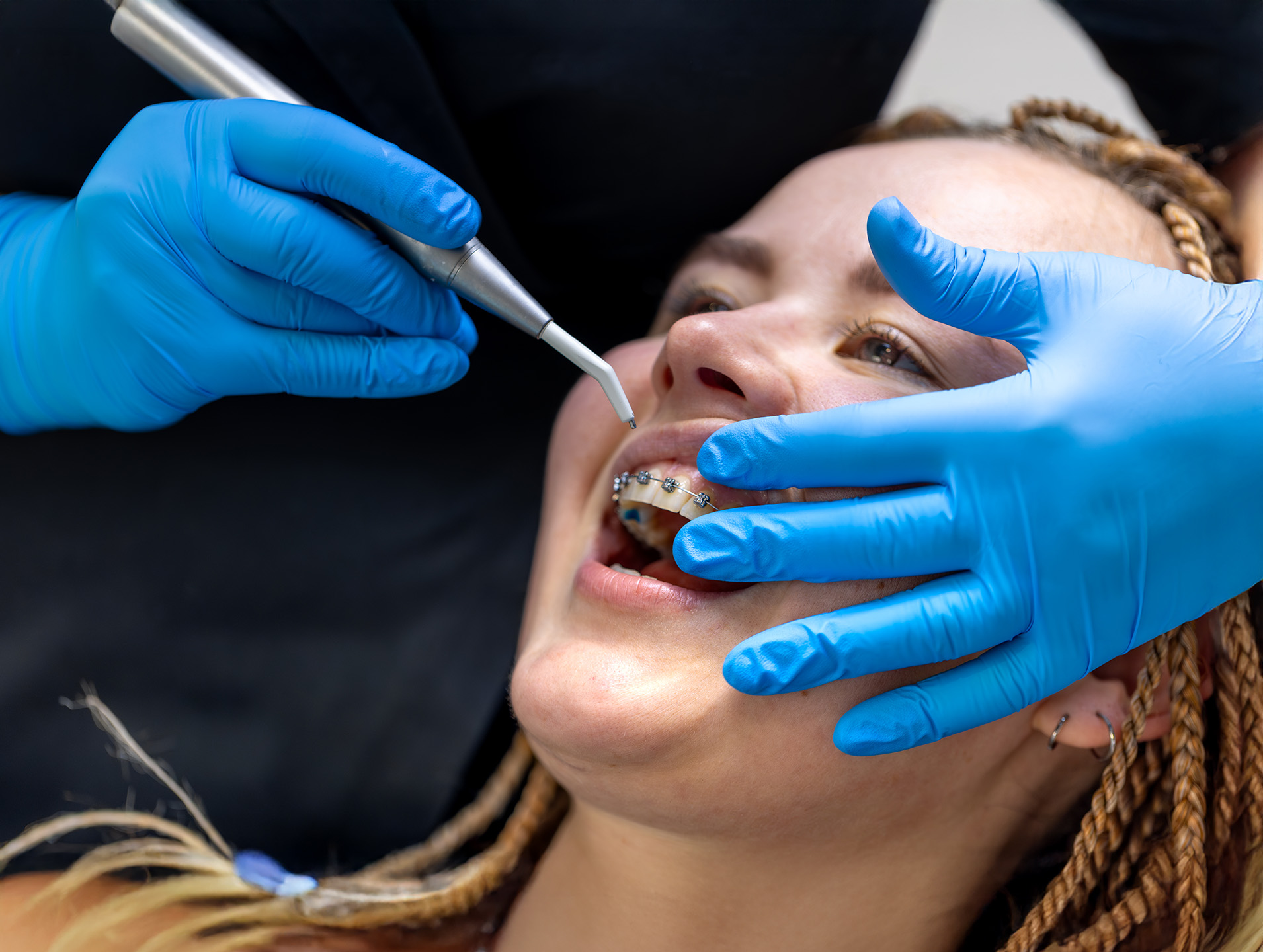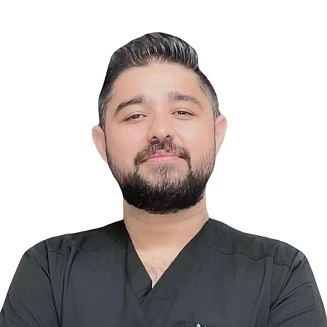Bite Correction
Expert orthodontics for adults and children

Service provided by
All doctorsWorld-Class Orthodontics at Polyclinic.ae
At Polyclinic.ae, orthodontic treatment follows global standards — precise, aesthetic, and medically sound.
Our experienced orthodontists correct both functional and aesthetic issues of the dental arches: misalignment, crowding, rotation, and improper tooth inclination.
A correct bite is essential not only for a beautiful smile but also for chewing, speech, gum health, and enamel preservation.
An untreated malocclusion can lead to headaches, bruxism, jaw pain, neck and back tension, and temporomandibular joint (TMJ) dysfunction. It can even affect posture and facial balance — causing asymmetry, muscle strain, and a “tired” look.
We take a comprehensive approach to bite correction, combining all modern methods and diagnostic technologies:
- Invisalign® and other clear aligner systems
- Metal, ceramic, and lingual braces
- Gnathological and orthopedic protocols
- 3D diagnostics and digital smile modeling
Our team treats children and adults, creating personalized plans that combine function, anatomy, and aesthetics.
In-House Digital Dental Laboratory
Our on-site digital dental laboratory ensures precision, quality control, and speed at every stage of orthodontic care.
We fabricate aligners, customized archwires, retainers, and other components within the clinic, eliminating delays and ensuring full integration with prosthetics, veneers, and bite rehabilitation.
The result is a unified “smile and bite” concept — designed, produced, and completed in one place.
Advantages of Orthodontics at Polyclinic.ae
Indications and contraindications
Frequently Asked Questions
- Do I need bite correction if my teeth are only slightly misaligned?
-
Yes. Even minor crowding can complicate hygiene, increase the risk of cavities and gum inflammation, and affect jaw function.
It can also alter the harmony of the lower face, making it less balanced. - How does bite affect facial shape and youthfulness?
-
An improper bite changes muscle tone and facial symmetry — leading to downturned mouth corners, a tired or elongated facial outline, and deepened nasolabial folds.
A correct bite supports a youthful, harmonious facial structure. - What is gnathology and why is it important in orthodontics?
-
Gnathology studies the interaction between teeth, jaws, and muscles in motion.
We apply it to evaluate how the bite affects the TMJ, posture, and muscle function, making it an essential part of our holistic orthodontic approach. - Which systems do you use for bite correction?
-
Treatment is customized for each patient and may include:
- Invisalign® aligners — discreet and comfortable
- Metal and ceramic braces
- Lingual braces (attached behind the teeth)
- Gnathological and orthopedic protocols for functional correction
- Aligners or braces — which is better?
-
Aligners are ideal for discreet correction and compliance-focused patients.
Braces are more universal and suitable for complex cases.
The choice depends on diagnosis, lifestyle, and aesthetic goals — your orthodontist will recommend the optimal plan. - Can adults straighten their teeth?
-
Yes. Modern orthodontics allows safe and effective correction at any age, provided the gums and bone are healthy and the patient is committed to treatment.
- At what age should children see an orthodontist?
-
A preventive check-up is recommended around 6–7 years old.
Early evaluation allows timely detection and gentle correction — or simple observation until active treatment is needed. - What if my jaw clicks?
-
Clicking often indicates TMJ dysfunction.
It can be caused by bite imbalance or muscle tension.
Orthodontic splints, bite correction, and gnathological therapy help relieve these symptoms. - Can I undergo orthodontic treatment if I already have implants or veneers?
-
In many cases, orthodontics is performed before prosthetics to optimize alignment.
If implants are already placed, the orthodontist will coordinate with a prosthodontist to ensure safe movement. - Is tooth extraction necessary for braces?
-
Not always. Modern techniques often create space without extractions.
The decision depends on anatomy and crowding level. - How long does orthodontic treatment take?
-
On average 12–24 months, depending on case complexity, age, and compliance (wearing aligners, attending checkups, maintaining hygiene).
- Are braces noticeable?
-
Metal braces are visible; ceramic and sapphire options are more discreet.
Lingual braces are completely hidden behind the teeth. - Can I whiten my teeth during orthodontic treatment?
-
Not with braces.
With aligners — sometimes yes, using whitening gels inside the trays (as advised by your dentist).
The best time is after treatment completion. - What happens after braces or aligners are removed?
-
You’ll wear a retainer (fixed or removable) to stabilize your results and prevent relapse.
- Is orthodontic treatment painful?
-
Mild discomfort may appear after new aligners or wire adjustments.
It’s temporary, manageable, and usually resolves within 2–3 days. - Can bite correction be done without braces or aligners?
-
In mild cases — yes.
We use micro-polishing, selective enamel reshaping, or restorative correction (veneers, inlays) combined with gnathological balancing. - What is orthopedic bite correction?
-
It’s the restoration of tooth height and shape using veneers, inlays, or crowns, often combined with orthodontics and gnathology — especially for worn or damaged teeth.
- Does bite affect speech?
-
Yes. Misalignment can cause lisping, unclear pronunciation, or speech difficulty.
Correction helps restore normal articulation. - What aesthetic changes occur after bite correction?
-
Facial symmetry improves, the chin and lips align naturally, nasolabial folds soften, and the overall face appears fresher and younger.
- What kind of care is required during treatment?
-
Meticulous hygiene, professional cleanings every 3 months, and the use of special brushes and irrigators.
We provide full instruction and supervision throughout treatment. - Can a bad bite cause headaches?
-
Yes.
Bite imbalance strains the jaw and facial muscles, leading to tension headaches or migraines.
Correction often relieves or eliminates these symptoms. - Can treatment be done during pregnancy?
-
In some cases, yes — if overall health and hygiene are stable, and with OB-GYN approval.
The second trimester is usually the safest time. - How much does orthodontic treatment cost?
-
It depends on the method, duration, and complexity.
We provide a transparent cost estimate after full diagnostics.
Installment and staged options are available. - Do braces affect speech or eating?
-
Only in the first few days.
Patients adapt quickly.
Aligners are easier — they can be removed for eating. - Where should I start if I’m considering bite correction?
-
Schedule a consultation.
We’ll perform diagnostics — 3D scans, CT, photo analysis — and create a personalized plan with options, timing, and cost.
Your path to a perfect bite and balanced face starts here.

